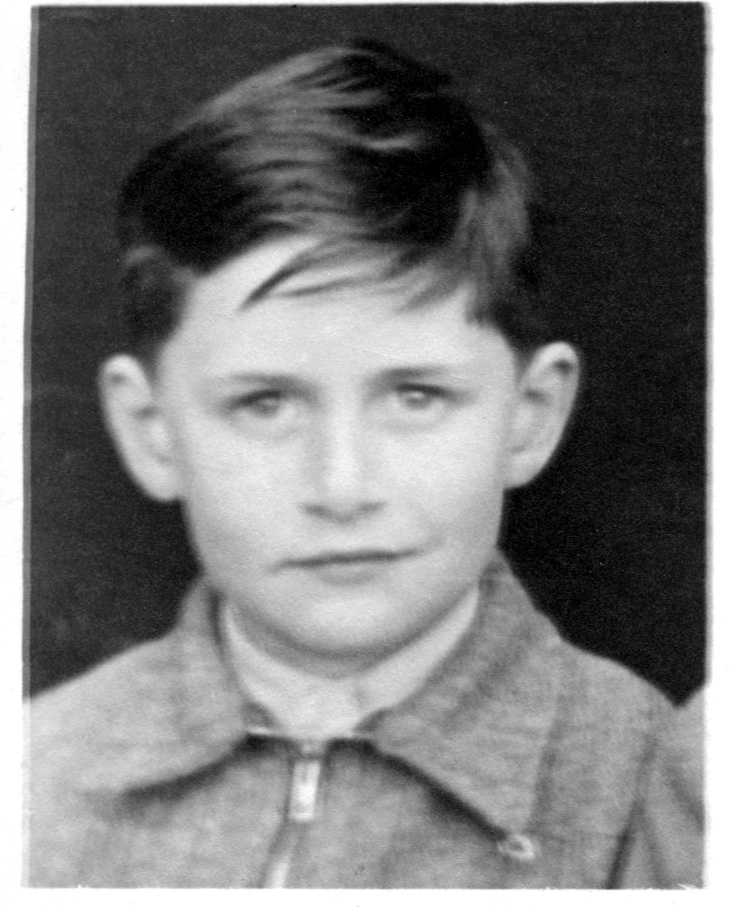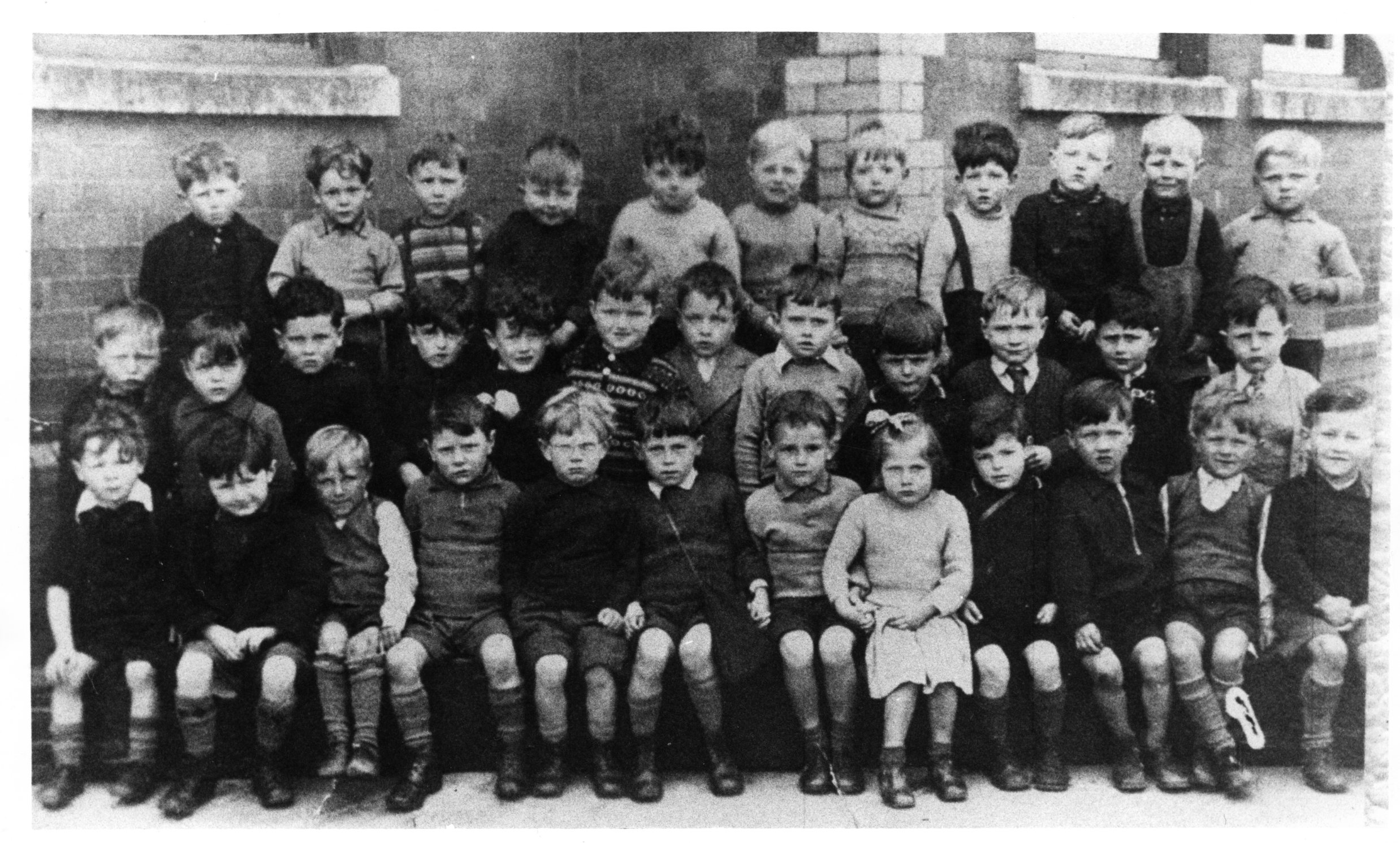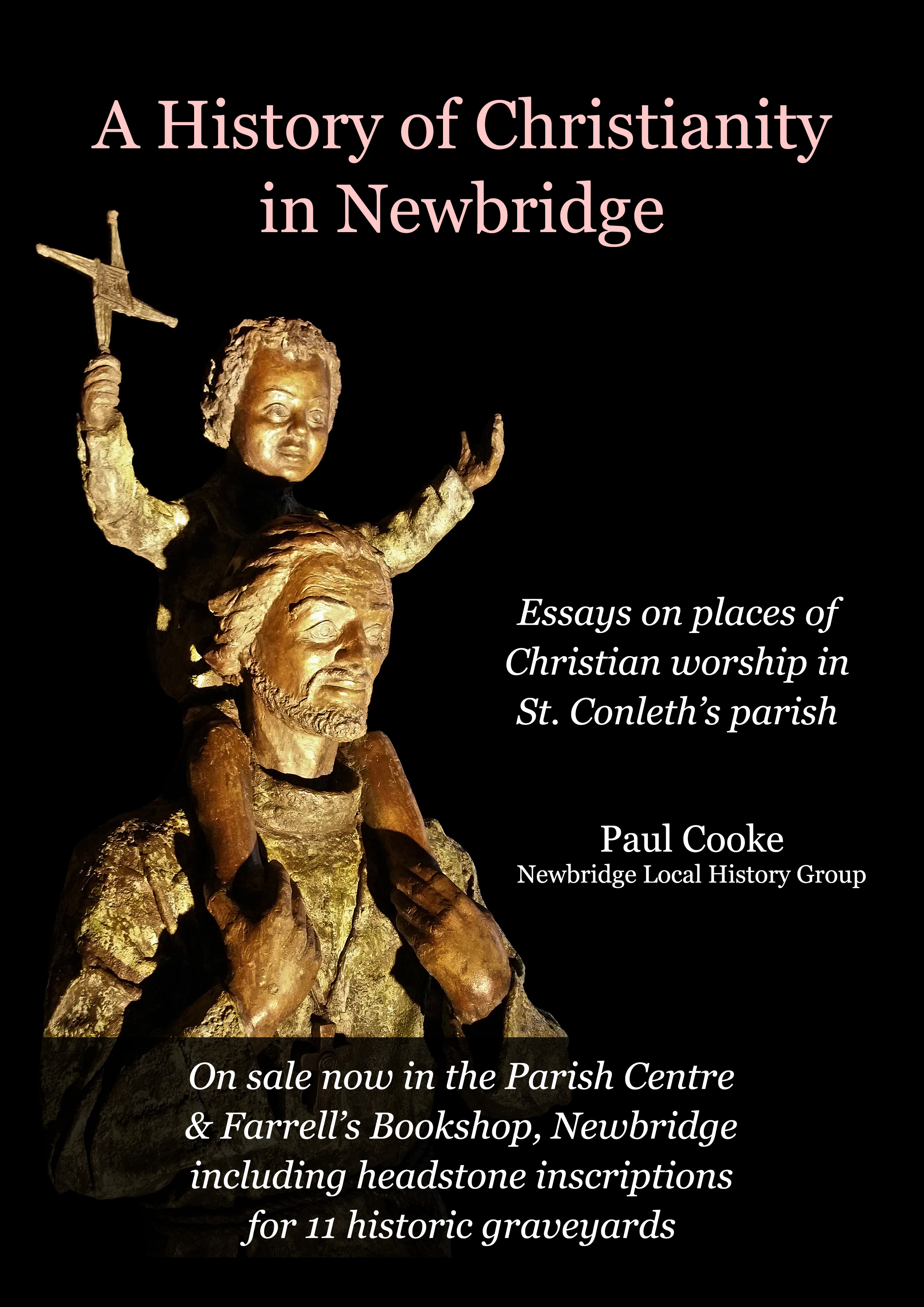Frank Boland: National School with the Nuns, 1947-1951.
National School with the Nuns:
 I attended St. Conleth’s Infant School, Newbridge, from 1947 until 1951. Situated in the red brick school building inChapel Lanedirectly opposite St. Conleth’sParishChurch, the infant classrooms were on the right hand side of the building. There is still a concrete plaque on the wall, marked “Infants”. The rooms on the other side of the building, further downChapel Lane, were for the boys and a plaque on the wall still signifies this.
I attended St. Conleth’s Infant School, Newbridge, from 1947 until 1951. Situated in the red brick school building inChapel Lanedirectly opposite St. Conleth’sParishChurch, the infant classrooms were on the right hand side of the building. There is still a concrete plaque on the wall, marked “Infants”. The rooms on the other side of the building, further downChapel Lane, were for the boys and a plaque on the wall still signifies this.
My route to school from No. 10 Liffey View in the Barracks was across what was then the open area behind our house and down through the gap between the Red Hall and No. I Liffey View (Craddock’s). I then went down the steep bank in front of the Red Hall and across the green and the remains of the cavalry hospital stable ruins and onto the Athgarvan road in front of what is now the now Town Linear Park. I remember my mother bringing me on a carrier on the back of her bike in my very early days. Her route was down the hill in the Barracks past Nos. 6, 7 and 8 Liffey View and out on to the Athgarvan Road at the Watering Gates.
All the teachers in the school were Holy Family nuns with the exception of Miss Deasy. She lodged in Grady’s on the Main Street (now the Ulster bank building). My first teachers were two elderly nuns; Sisters Gonzaga and Philomena. The other teachers that taught me were Sisters Benignus, Aloysius, Michael and Ann Joseph. The girls were taught by Sisters Veronica, Rose and Miss Deasy.
I suppose the greatest impression on my young mind was the image of the nuns in their strange attire. To meet with these ladies dressed in long black dresses with long black sleeves and a long black veil covering a white cap on their head was a very new experience. Their cheeks, necks and foreheads were enclosed with a stiff white material which also covered their shoulders and chests (this garment is called a wimple or guimpe). Only their faces were visible and their strange appearance was a great culture shock to us young boys. This stiff headgear on their face and neck appeared very uncomfortable and I recollect them trying to stretch it with their fingers. They wore a large cross on a chain around their neck. A large pair of rosary beads hung down from their waists and it swished and rattled as they moved. They wore a knitted or crocheted black cape around their shoulders in the cold weather. They had a pocket watch underneath the starched white breastplate. A white hankie could be produced from a pocket in the swirling skirt. Generally speaking, the nuns would have had little presence in the wider community then and were definitely foreign to us boys. We were unsure of their species and also thought that they had no hair. Their public appearances would have been confined to the schools, and even when attending religious services in the church they were confined to the nun’s oratory beside the altar (now the adoration oratory). They did visitations in pairs around the town on Saturday afternoons. I do have a recollection of the exotic sight of a pair coming through the Barracks on a regular visit to Kitty Morris, who lived in E Block and was confined to a wheelchair.
There was no standard garb for the pupils and we all dressed in a multitude of different outfits. School uniforms were not on the agenda then. Jumpers/pullovers, shirts and short trousers with braces (or sometimes belts) were the order of the day. Sleeveless pullovers were worn in the milder weather. Corduroy jackets (over your head) with elastic waistband and corduroy trousers were popular rigouts. Long gabardine coats were common as top coats. Long socks up to the knees in the winter and short socks for the fine weather were worn. Elastic garters, when available, were worn to keep the long socks up but it was not unusual to see many cases of long socks down around the ankles. Footwear varied considerably and sandals and runners were common in the summer. Winter footwear required sturdier shoes and boots, and the hob-nailed boot was very popular. These were pre-Doc Marten style. They would have flat headed nails in the heels and toes and/or steel rims on the heels and toes. The purpose of these additions was to save the wear and tear of the leather. However, they also facilitated a good slide and could produce some sparks as well. The wellington, or Russian high rubber boot, was also widely worn in wet weather. Some boys had to wear them more regularly for economic reasons. The rubbing of the top of the boots tended to wear a mark on the bare legs if worn for long periods and consequently, the practice was to turn down the top rim. Headgear was usually a cloth cap or beret and different types of balaclava. As regards school bags, various types of bags met the requirements and Army issue was not uncommon. The current standard types were not very prevalent. Pencil cases also came in various forms and the red Oxo tin often came in handy. I remember getting a proper pencil case/box for my birthday. It was made of timber and had two levels and a sliding opening on top. The top level revolved to reveal the bottom level.
My earliest memories of the school building were the steps up to both the front and back doors and the thumb- latch on the heavy doors. You needed both hands to operate the latch. Inside the doors, the floor of the large hall was paved with red stone tiles which became very slippery when wet. This hall became a maelstrom of children at break and at the end of the school day, and it was the scene of many a collision and resultant fall. The walls were lined with steel hangers for the children’s coats. There were three classrooms on one side of the hall and these were divided by a movable partition. This partition was made of timber on the bottom six feet or so and with glass windows on the top portion. There was also a door in each partition. The partition could be folded on fixed runners on the floor like a concertina. I remember a mouse being squashed once in this exercise. The partitions were opened to create an assembly hall for concerts and performances of the pantomime. The classrooms on the other side of the hall were for the girls.
Class rooms were dominated by the freestanding blackboard, teacher’s table and the steel framed pupils’ desks. The blackboard stood on an easel at the front of the class. A cloth duster hung on a hook on the easel. The desks seated two pupils and had a timber table top, slightly sloped, an inkwell hole with a sliding cover, and grooves in the wooden top to hold pencils and pens. There was a narrow seat on hinges that allowed it to be lifted up to make room for entering and leaving. The floors were timber planks; I’m not sure if they were tongued and grooved. I remember them being swept after school hours by Paddy Cullen, the sacristan cum caretaker. He used to scatter damp sawdust to keep down the dust when sweeping. Another feature of the classrooms was the heavy black iron pipes for the central heating which went around the perimeter walls low down. There were also some large black heavy radiators. The central heating was operated by Paddy Cullen who fed the furnace down steps outside the back door.
The playground was the yard outside on theNaas Roadside (now the car park). It was surrounded by what seemed like a high wall to us, about 4 feet high, and with a locked double gate at the corner ofChapel Laneand theNaas Road. There was a large open shed on the perimeter adjoining the monastery and this gave cover in wet weather. The yard ground was covered with gravel and stone throwing was strictly forbidden. I remember breaking this rule once and this resulted in me cracking a downpipe on the shed. Sister Michael admonished me and said that my uncle, Tom Curran fromChapel Lane, the plumbing contractor, would now have to be called to repair it. I was suitably concerned. Well, just enough to remember the incident after about 66 years. There was a large chestnut tree in the corner besides the monastery building at the bridge. It was a very popular place during the conker season. The morning and lunch breaks, for those who did not go home for lunch, were generally spent here in the playground. I lived close enough to the school to be able to go home for lunch which was for half an hour between 12:30 and 1 o’clock. I do remember running back to school on hearing the factory hooter and jumping up at the playground wall to see if anyone was still out in the yard. Those who did not go home for lunch had their sandwiches (jam was very popular) and drink of milk (small bottle) in the yard shed. There was timber seating along the shed walls. There was always a nun on patrol overseeing activities in the yard. Sometimes the altar nun, whom I met later in my altar serving days, was on duty. The nun patrolled with her arms folded under the starched white material. A hand held bell would be rung to signal the return to class. The toilet buildings were situated outside in the yard near the backdoor. Now they may have left a bit to be desired and I can’t say that I have favourable memories of their standard. I do remember that a request in Irish “an bhfuil cead agam dul amach, le do thol” was required to answer the call of nature during class.
My earliest classes in baby infants were taught (probably too strong a word) or controlled (how about facilitated?) by Sister Gonzaga, and also Sister Philomena. I thought Sister Gonzaga was very elderly but she probably wasn’t (more than likely, she was younger than I am now). I can’t recall the intake of any knowledge but do have strong memories of rolling plasticine (play-doh) and many are the snakes and eggs of various lengths and sizes that were created with it. There were treats of a ride on the rocking horse and also sweets produced from under the delph laying/clocking hen available as incentives. The wooden rocking horse was fixed to a rigid frame and only moved relative to the fixed frame when ridden. The hen sat on its nest on the window sill and was lifted to collect the sweets that it laid for the good boys and girls. Not sure of when the co-education aspect ceased and it was certainly finished by First Communion class. Apart from the aforementioned plasticine (play-doh), our other educational tool was a small personal blackboard, about 12 inches square and white chalk. Not sure if we stretched to any other colour chalk.
Sisters Benignus and Aloysius were also my two teachers in the infants’ class. Whilst I remember them, I cannot remember any specific details referring to them in the classroom. Irish formed a significant part of the curriculum. You learned your name and the various greetings and phrases such as “cad is ainm duit?”, “cad e sin? and the appropriate responses early on. The roll-call in the morning elicited the response “anseo, a Shiuir”(present/here, Sister). Irish was the spoken medium of the class.
Sister Michael was my teacher in the First Communion class I remember the actual first communion and first confession themselves. We had trial communions and practised taking a dummy host on our tongues without biting the host or the nun’s finger. The option of receiving in the hand was not available in those days. Practice was required to allow the host dissolve itself in the mouth as chewing was not permissible. As regards the first confession, the main difficulties were the darkened confession box and the identification of the sins for confessing. Sister Michael suggested some acceptable ones and I’d say that the priest was pretty bored that day with the widespread repetition. The day of the First Communion itself is memorable for the white rosette on the new suit and especially for the “breakfast” in the convent. I clearly remember the treat of a sticky bun. Photographs were also taken and I’m not forgetting the visits to neighbours and relations for viewing and “collecting”. No! I don’t have it still. Speaking of finances, I do remember the penny collection for the “black babies” in Sister Michael’s class. She had a weekly draw for those who contributed. Those who subscribed were given the chance to win a prize by guessing the number she had written on the back of the blackboard. I used to collect a penny each from my parents, grandparents and an aunt and uncle. My mother told me to tell Sister Michael that I was only to get one guess despite my “large” contribution. I remember being unhappy with this ruling. Anyway, I’m sure that the class was responsible for many christened black Patricks. I have a vague recollection of Sister Michael having baptism cards with a picture of a black baby with the name Patrick on them.
Sister Ann Joseph was my teacher in first class. The girls in first class were taught by Sister Rose. I have a firm recollection of a calendar for 1950 or 1951 with a picture of Pope Pius X hanging on the wall. He was beatified in 1951 which would possibly explain the relevance. The whole school occasionally, perhaps on the First Fridays, went across the road to the chapel (St. Conleth’s Church) for rosary and benediction. I remember a lady with a walking stick, Miss Johnson from Old Connell Stud (Hurley’s Moat), always attended and always sat in the front pew up beside the altar. I was in the second row once and she sat up against my rosary beads and, she being a rather heavy person, they ended up being broken, probably because I pulled them to release them. I’m not sure at what stage we graduated to using pen and ink or writing between the lines but I presume that it must have been in first class as I do remember a nun (not sure which one) circling an ink blot on my copy with red biro. The blotting paper unfortunately failed to destroy the evidence. I managed to survive the resultant trauma of the red circle with no lasting mental damage, thankfully. The ink that we used was made up in the school in bottles with a mixture of water and powder. I don’t have a recollection in the Nuns of anything to do with pens and nibs or the ink wells. Those memories come later of my time in the Brothers.
My time with the nuns finished in the summer of 1951 and later that year, I made the long trek from the Barracks up to Charlotte Street (now the Parish Centre) for second class with the Patrician Brothers. Sin Sceal eile.

The following are the names in the photo:
Back Row L to R: Mick Kennedy, Paddy Tidd, Tom Rochford, Joe Doherty, Tony Dunne, Paddy Hensey, Ber Crummy, Kevin Keogh, Mick Moran, Joe Coffey, Dinny O’Brien.
Middle Row L to R: Donie Bowdren, -------, Tony Lumsden, Frank Tinsley, Mick Curran, John Hayes, Paddy Allen, -- Conroy, Tommie Whiteley, Will Murphy, Frankie Boland, Tony White.
Front Row L to R: Paddy Reck, Tom Kennedy, Tom Butler, Tommie Higgins, Paddy Farrell, Mick Halford, Con Doherty and sister Mary, Mick Riordan,Noel Dunne, Hughie Garrett, Paddy Dowling.
The following boys were also in this class: Gerry O’Connor, Tommie Brennan, Connie Moore, Niall Conlon, Tony Mooney, Conal Bradley, Phil Murphy, Joe Hughes, Laurence Frazer, Michael Cooney, Dessie O’ Brien, Paddy Kenny, Frankie Rooney, Mick Gorman, Noel McDonagh and Fergus Brennan.
Jack McKenna, Brendan Lawler, Ollie Meade, Joe France, John Joe Geraghty, Mick Doyle, John (Sonser) Maher, Seamus Morning, Mark McCormack, Paul Mullally, Joe Shaughnessy, Stan Deegan, George Crolly. Paddy Reilly, Benny Dowling, Michael O’Connor and Tony Sinnott.

